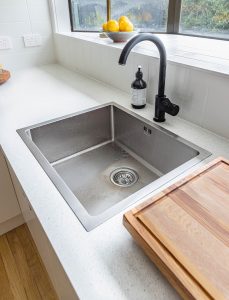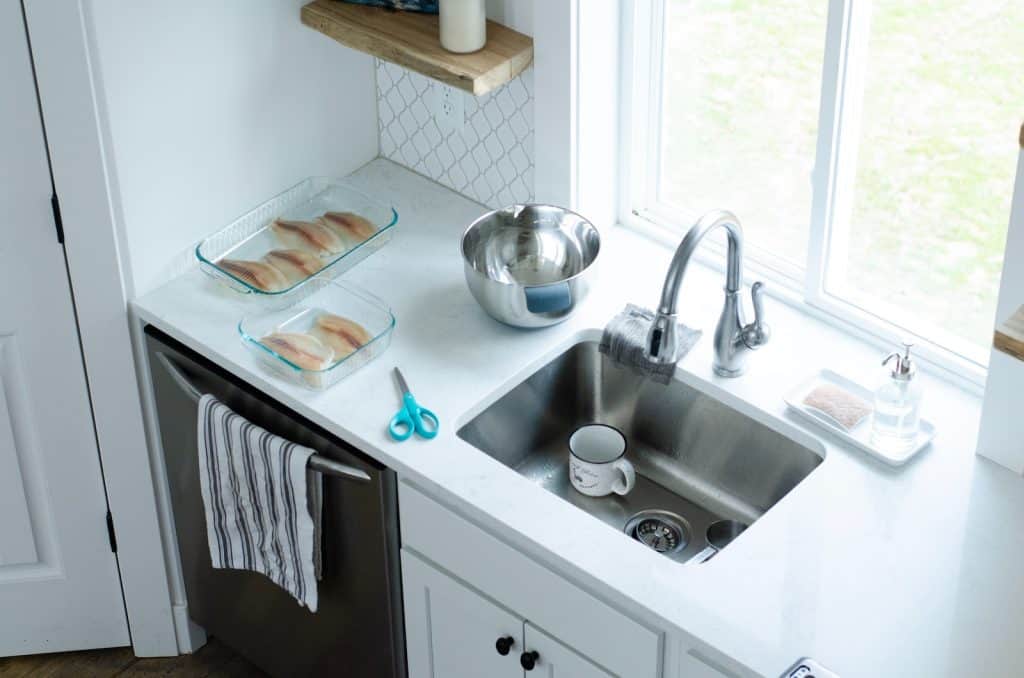A squeaky-clean kitchen is the heart of a healthy and happy home. However, the kitchen sink, while bearing the brunt of dirty dishes and food scraps, often doesn’t get the attention it deserves. Given the role it plays, learning how to clean a kitchen sink is essential. From porcelain to stainless steel, this guide covers how to breathe new life into your sink, no matter the material.
Steps on How to Clean a Kitchen Sink

Identify your sink type: From porcelain sinks to stainless steel kitchen sinks or copper sinks, each type requires a different cleaning method.
Using Dish Soap and Baking Soda
For a stainless steel or porcelain sink, start with warm water and a few drops of mild dish soap. With a soft cloth, wipe down the entire sink, including the sink drain. Next, sprinkle baking soda directly onto the sink surface. Using a soft sponge, scrub the mixture in a circular motion. Rinish the sink completely with hot water.
Using White Vinegar
White vinegar is a natural cleaner that’s great to clean a kitchen sink. It’s also excellent for the garbage disposal. Pour one cup down the drain and let it sit for a few minutes before running boiling hot water to clear it out. A mixture of baking soda and vinegar provides a deep clean, removing even tough stains.
Clearing Debris from the Sink Drain
A kitchen sink drain often gets clogged and harbors food debris or raw meat particles. To clean your kitchen sink drain, first, use boiling water to loosen and dissolve the particles. For stubborn clogs, you could also use a soap and hot water mixture.
Cleaning the Garbage Disposal
Ice cubes and a few lemon wedges can help clean the garbage disposal. Lemon eliminates unwanted odors, leaving your sink smelling fresh. For tough grime, consider a mixture of salt scrubs and cold water.
Specialty Cleaning Products
Aside from dish soap, baking soda, and white vinegar, some other cleaning products help maintain a clean sink.
Hydrogen Peroxide
Hydrogen peroxide is an effective bleach substitute for cleaning kitchen sinks, particularly porcelain sink. Soak a soft cloth in it and wipe the sink surface. It’s great for removing tough stains.
Olive Oil and Lemon Oil
Olive oil or lemon oil can be used for a final polish. Apply a few drops to a microfiber cloth and rub it in a circular motion over the sink surface. This will give your sink an appealing, shiny clean look.
Essential Oils
Essential oils, like tea tree or lavender, can provide the added benefit of leaving your sink smelling wonderful. Just add a few drops to your soapy water.
Maintenance Tips for a Clean Kitchen Sink

Cleaning your kitchen sink mustn’t be a once-in-a-blue-moon activity. Regular cleaning prevents build-up of food particles and unpleasant smells.
Avoid Leaving Dirty Dishes
Leaving dirty dishes out can attract bugs and create foul odors. Make sure to clear and clean your sink every day.
Regularly Clean Sponge Holder
The sponge holder can harbor germs if not frequently cleaned. Consider a weekly deep clean to keep it bacteria-free.
Final Thoughts
Regular cleaning is the key to a healthy, fresh-smelling kitchen sink. With some basic household items and a bit of elbow grease, you can have a spotlessly clean kitchen sink. Everyone can accomplish this task; the beginner estimated cost is low, and the result is highly rewarding. Just remember to switch out cleaning tools regularly and ensure to dry your sink completely to avoid water spots and lingering bacteria. Keep your sink sparkling clean and your kitchen space ready for culinary magic at any moment.

